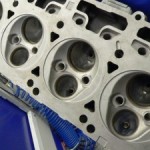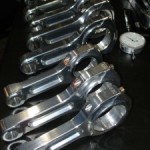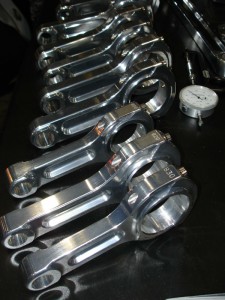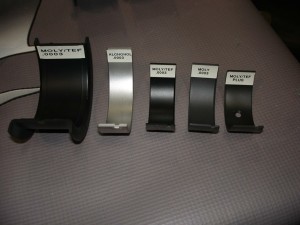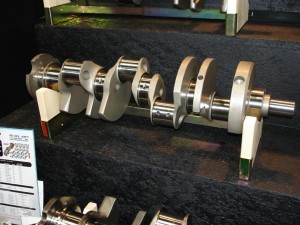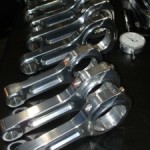Heads are a product line that warrant almost constant research. Both the OEMs and aftermarket are creating new applications that solve problems, save time or money and just generally make life easier for engine builders. But, these improvements are only beneficial if those builders know what is out there waiting to help them.
So, we asked a number of cylinder head manufacturers about selection, technology, and even if the OEMs are doing it right. Some of their answers may amaze you, but they definitely will educate you on today’s heads.
We started with the ‘chicken or the egg’ of head questions – what are the best criteria for selecting a set of heads in a performance build. The basics are always best for this question, but, like knowing what is on the market, it’s always good to see what’s new.
For some high-end performance heads, a raw casting is CNC machined to specific dimensions for that application to deliver peak performance.
One Ohio-based manufacturer told us how he does it, “I have to know everything about the build and what it’s to be used for. Even about the driver and track size that it will be primarily used for and what the customer expects. And last but not least, how much money the customer has to spend. We find that a lot of potential customers can’t afford to do it the proper way. We ask that they do a little at a time so they aren’t spending their money twice or three times and getting discouraged and go and do some other form of entertainment.”
A California-located designer and manufacturer of cylinder heads provided his punch list, saying, “I would say the most import parameters to keep an eye on would be engine displacement, compression ratio, camshaft style, (and aggressiveness) RPM range, and application (street, drag, road race, marine, etc.) when selecting the ideal head for your project. Everything I just listed plays a large role in head selection with ‘compression ratio’ possibly playing the least importance, although an engine with high compression should automatically boost all the other parameters (more RPM, larger cam, etc.) helping by default to guide you into a larger, higher flowing head that would better fit that more aggressive application. The key is really looking at the intended application and building a motor purpose built to best optimize and compliment the type of power curve and engine manners that application dictates is best. A street car will always have compromises made in an effort to keep it friendly on the street so a smaller head than what you might consider in the same vehicle that only sees the strip is likely going to bring better overall results with the cam and other components also matched/selected to give it a more dual purpose personality. A high compression drag race engine is just the opposite. It lives from 5000 – 8000 RPM, hypothetically, and performance below 5K isn’t a consideration with larger, more aggressive cams, larger heads and manifold all make sense.
“The right combination of parts is paramount in extracting the most the heads have to offer in the particular environment you will be utilizing them – not only is selecting the right heads important, but the rest of the supporting bits and pieces as well,” he continued. “The hardest running engines are usually the most sorted out and perfectly optimized with all the components complimenting one another.”
An Alabama-based head manufacturer listed his top factors, “When a person is looking at a set of performance heads, there are several factors that figure into the equation. First off, is the size of the engine. I have customers all of the time that call and want to put a 225 runner cylinder head on a SBC 355. This is a deal where bigger is not better in most applications, which leads me to factor number two. Application; cruiser, street/strip or all-out race. This is a big factor because it determines the RPM range in which you want your engine to run its best. Another factor is the camshaft. This is what usually determines the spring package for each head. These are just a few of the factors we consider before we suggest a cylinder head for a customer. It’s been our experience to supply the proper size runner, combustion chamber, valve and springs for a total package that meets customer’s needs.”
The Tennessee racing head manufacturer agreed. “The basic criteria to begin with are the size of the engine, compression ratio, fuel type and application. Then, the engine builder needs to define their intended horsepower, torque and RPM band. This information will be used to identify the runner volume and combustion chamber size. The most common mistake we see is when individuals choose a larger runner volume head with impressive high-lift flow numbers. Unfortunately, these ‘big’ numbers do not necessarily translate into ‘big’ power for their application. Though the big flow numbers are impressive, they are not indicative of the performance of the engine. Quality of the airflow and the overall curve are much more important in achieving the desired outcome and making power and torque when and where needed.”
Another Ohio-based manufacturer added one more factor. “We feel the best criteria for selecting a set of cylinder heads is to know the cubic inches of the engine, the RPM you want to turn, the application and the weight of the car. From there, you can select the correct runner size and the amount of air flow required to support the engine.”
As head builders, our sources are even more tuned into the market than most folks. So we asked them for some of their intel on any new OEM technology on heads that may be a factor for engine builders now or in the future.
Head Games: Small block Chevy cylinder heads are installed during a COMP Cams Engine Builder Duel, as teams race against a clock in a performance engine building competition. Similar competitions are held at performance trade shows by seasoned engine builders, as well as youth, in competitions such as the Hot Rodders of Tomorrow.
The California manufacturer said, “Right now, the newest technology is DI (Direct Injection) where the fuel is sprayed under very high pressure directly into the combustion chamber instead of the manifold or intake port of the head. It’s much more precise and offers the end user more torque, more fuel economy, and more power. And my guess is most of the OEMs will be implementing this technology into their entire line up of cars in the next few years. Even the more sedate basic transportation models; in an effort to better meet the tightening CAFE standards without imparting power output in a negative fashion.”
While another head manufacturer echoed that with a simple, “direct injection issues” response, one of the spokespersons we interviewed sees a different issue. “The major thing that we see, which is not really new, is the overhead cam. It seems most engines on the OEM side are using this technology. I often wonder does this just complicate something that did not need complicating. We see cam journals damaged everyday on these heads. I can only speak of my personal experience, but I have had multiple Chevy trucks with 200,000 to 350,000 miles that I never had a moment’s trouble out of with the old push rod technology.”
Another aftermarket manufacturer addressed a different issue. “Today’s OEM heads are a big factor in the aftermarket. Gone are the days of ‘smog’ heads that choked down horsepower and limited the engine builder. Since the introduction of fuel injection and advancements in design software and computer aided modeling, the OEMs have had the ability to design fuel efficient, emission-friendly engines that still have the ability to make good horsepower.
“This has opened up the option for engine builders to use off-the-shelf parts that do not require a lot of modifications to achieve their performance goals. At the same time, it has educated the aftermarket and provided those folks with the ability to push the envelope a little further. In addition to improvements in the cylinder heads, the OEs have improved some of the valve train components that, with some inexpensive upgrades, can be used in performance applications.”
An Ohio manufacturer also addressed OEM technology. “As far as new technology from the OEMs, they are making progress, but you just can’t get the same performance from them that you can get from the aftermarket.”
With the proliferation of heads flying out of casting shops these days, we wondered what our sources have seen as far as any new technology in any OEM or aftermarket heads.

According to one cylinder head maker, the demand for larger, higher-flowing heads is just is one of the options engine builders are looking for when building today’s performance engines.
The Alabama supplier said he’s seen improvements, too.
“It seems to me that both the OEM and aftermarket head manufacturers are constantly raising the bar in performance. While this newest technology is usually expensive, it is amazing what is being done but right now. If I were putting together a performance application, give me an old school big block.”
The Tennessee supplier returned to the DI issue. “Direct injection is the latest technology that is being introduced at the OEM level. The placement of the injector into the combustion chamber allows the computer management system the ability to adjust the amount of fuel needed for the given condition, and lets it determine at what point of time during the combustion cycle fuel is needed.
“The result is more efficient combustion, which also results in more power with less waste. This is a big plus when the emissions in an OE application need to be limited. This technology is migrating into the aftermarket where we can utilize the OE architecture and adapt that technology to all-out performance applications without the limitations of fuel economy, emissions and manufacturing cost,” he said.”
The second Ohio manufacturer spoke on both the tech and production, “As far as new technology going into cylinder heads, we use a lot of wet flow development coupled with a CFD program when developing a new port or chamber design. Then, of course, we back that up with testing on the flow bench, dyno and race track.
“From a casting side, we are always looking into different alloys and processes that are being used in the Aerospace industry to see how they could benefit us in the aftermarket automotive performance business. And we are seeing some things there that look very promising,” he said.
The California supplier chimed in as well. “Variable valve timing comes to mind here as well. Some systems are more elaborate than others, but all of them are allowing the valve events to optimize the RPM range and load the driver commands with his right foot,” he said, adding, ”This allows an engine to act like it has a very small cam, down low, boosting MPG, low speed torque, and part throttle response. At the same time it’s able to hang on upstairs making big power at high RPM and not rolling over quickly past peak power (the camshaft events now optimized for that part of the RPM band).”
One of the Ohio head manufacturers said he hasn’t seen much in the way of new improved OE technology, yet opened up an area for a new product. “There’s nothing that I am impressed with. The new Vette LT motor is nice, but there is lots of improvements that could be made to the head layout.”
Lastly, we asked our sources what engine builders are asking for in new heads?
The West Coast manufacturer said they want products that they can build better with.
“Lighter components are popular and also the demand for larger, higher-flowing heads as the ability to build larger motors becomes more affordable (which then places a higher demand on the cylinder head to properly feed the larger “air pump” beneath them). This is truly the golden age of hot rodding with the largest difference being you can make big power now thanks to modern technology without paying the penalty of poor driving manners and poor fuel economy.”
Another supplier said the answer to what builders want is simple, “Engine builders want quality. And, they want to put their name on quality. We are constantly improving our products to offer the maximum quality and performance at a minimum price.”
One manufacturer responded that he sees more growth in engine sizes and performance.
 “What we have been seeing engine builders ask for are cylinder heads to feed more cubic inches and turn more RPM. They want this and want to keep it user-friendly. This is what spurred the development of our new Sniper XL cylinder head. This is a 24 degree conventional BBC head that flows over 500 cfm. This cylinder head has been designed with all of the latest technology while working very closely with engine builders and other manufactures that will supply different parts for the head.”
“What we have been seeing engine builders ask for are cylinder heads to feed more cubic inches and turn more RPM. They want this and want to keep it user-friendly. This is what spurred the development of our new Sniper XL cylinder head. This is a 24 degree conventional BBC head that flows over 500 cfm. This cylinder head has been designed with all of the latest technology while working very closely with engine builders and other manufactures that will supply different parts for the head.”
Another manufacturer believes the LS market is really picking up steam. “We can offer builders the latest and greatest for all forms of racing. We also make heads that will stand 3500 HP of abuse.
The Midwest manufacturer also addressed tomorrow’s LS applications. “The cylinder head aftermarket is growing at a rapid rate. Larger cubic engines continue to push the airflow requirements from the cylinder heads. In addition, the trend towards late model engines continues to grow.
“We, too, place a lot of emphasis on our LS cylinder head line, where we offer a variety of runner, valve size and combustion chamber configurations to fit anything from a 3.900″ bore OE block all the way to heads to accommodate 500 CID with our LS block.
“The large cubic inch engines are not just limited to the race track, however, as they are becoming commonplace in the street market, too. Big cubic inch, high-horsepower pump gas engines are becoming the norm. We have also experienced a trend that our engine builders are looking to purchase heads that are ready to install right out of the box, from CNC-ported to fully assembled heads.
“In the past, most engine builders liked to put their finishing touches on the cylinder heads themselves, but with the variety of heads and options available today, and the quality components in our assembled heads, there is no need to invest additional labor hours.”
Heads have always been a quick fix for adding and even controlling how an engine runs. With today’s increasing selection of products and application, that quick fix can even receive a tune up.
The post The Latest Improvements on Performance Cylinder Heads appeared first on Engine Builder Magazine.
Read more here: Engine Builder Magazine

